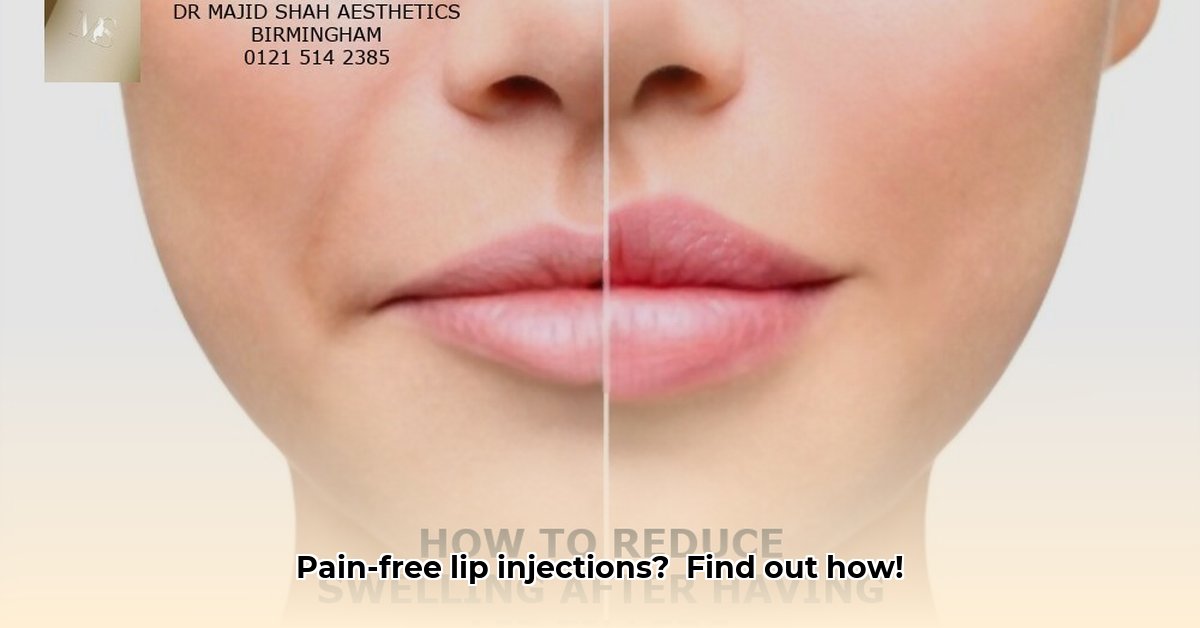Thinking about lip injections? The big question is: does it hurt? This guide will give you the lowdown on lip filler pain, walking you through the whole process from start to finish. We’ll cover what affects how much it hurts – your pain tolerance, the numbing stuff they use, how skilled your injector is, and even the type of filler. It’s not just about avoiding pain; it’s about feeling confident and informed so you can make the best choices for yourself. We’ll help you understand what to expect, how to minimize any discomfort, and how to find the right person to do your injections. For more on potential issues, see our article on [bad lip injections](https://chaztin.com/bad-lip-injections/). Let’s get you ready for perfectly pouty lips!
Understanding Lip Fillers and Discomfort
Let’s dive into lip injections – and the question on everyone’s mind: do they hurt? The sensation during lip augmentation is often described as a slight pinch or pressure. Most people find it manageable, especially with the use of numbing agents.
The Role of Hyaluronic Acid
Lip fillers primarily involve the administration of dermal fillers to enhance lip volume and contour. Hyaluronic acid-based fillers are among the most prevalent, given their biocompatibility and temporary nature. By attracting moisture, these fillers provide an immediate plumping effect that can last several months. The lip filler procedure requires careful preparation and aftercare to ensure optimal results and manage any potential side effects.
Hyaluronic acid, a naturally occurring substance in the body, plays a crucial role in maintaining skin hydration. When injected into the lips, it binds with water molecules, thereby increasing the volume and defining the lip borders.
Factors Influencing Discomfort
Several factors play a role in how much discomfort you might experience:
- Individual Pain Threshold: The inherent variability in pain tolerance among individuals is a significant determinant. What may be mildly uncomfortable to one person could be more intense for another.
- Practitioner Expertise: The skill level and experience of the injector play a critical role in mitigating pain. Experienced practitioners employ techniques that minimize tissue trauma and discomfort.
- Pre-procedural Anxiety: Anxiety can exacerbate the perception of pain. Patients who are well-informed and relaxed typically report a more tolerable experience.
- Injection Site Sensitivity: The lips are densely innervated, making them particularly sensitive. However, the careful application of anesthetics helps mitigate this sensitivity.
Minimizing Discomfort: Preparation and Techniques
Patients are advised to abstain from blood-thinning medications and supplements, such as aspirin or fish oil, prior to the procedure to reduce the risk of bruising and swelling. Moreover, practitioners often recommend avoiding alcohol and caffeine, as these can amplify discomfort.
Here are some common techniques used to minimize pain:
- Topical Anesthesia: The application of numbing cream approximately 20-30 minutes before the procedure significantly reduces pain perception.
- Ice Application: Applying ice to the lips before and after injection can constrict blood vessels, reducing swelling and numbing the area.
- Distraction Techniques: Engaging the patient in conversation or providing a stress ball can divert attention away from the sensation of the injection.
- Nerve Blocks: In some cases, a dental nerve block can be administered to completely numb the lips.
Your Lip Injection Journey: A Step-by-Step Guide
When you go in for a lip filler injection, the process is straightforward and designed to minimize discomfort.
During the Procedure:
Initially, a healthcare provider will apply a numbing cream to your lips to ensure the area is desensitized. This step is crucial in making the procedure as comfortable as possible. Once the numbing cream has taken effect, the provider will use a thin needle or cannula to inject the lip filler into specific areas of your lips. The entire treatment typically takes around 30 minutes to an hour. Most patients report minimal pain or discomfort during the procedure, often describing the sensation as a slight stinging or pricking. The use of topical numbing creams, lidocaine in the fillers, and the injector’s technique plays a significant role in reducing any discomfort, making the experience manageable for most individuals.
After the Procedure:
Once the procedure concludes, the focus shifts to recovery. Mild swelling and tenderness are common. These effects are usually temporary, subsiding within a few days. Immediately after, applying ice packs can help. The cold reduces swelling and numbs the area, offering relief. It’s a simple yet effective strategy. Following aftercare instructions is crucial. This ensures a smooth recovery and minimizes discomfort. Each practitioner’s advice may vary, so adhere closely to their guidelines.
Here are some aftercare tips:
- Applying Cold Compresses: Regular application of cold compresses post-procedure can alleviate swelling and numb any residual discomfort.
- Gentle Lip Care: Avoiding excessive pressure or manipulation of the lips in the immediate aftermath of the procedure prevents aggravating the injection sites. Using gentle lip care products soothes the lips while healing.
- Hydration and Moisturization: Maintaining lip hydration with lip balm aids in the healing process and enhances the longevity of the filler.
- Avoiding certain activities: Avoiding strenuous activities will help prevent further swelling. Avoiding smoking and alcohol will promote faster recovery.
Over-the-counter pain relievers might be advised for any lingering discomfort. Ensure they are taken according to the practitioner’s recommendations. Staying well-hydrated and sticking to a healthy diet can also support the healing process. For longer-term care, consider scheduling a follow-up appointment to assess results and address any concerns.
The Importance of Choosing the Right Injector
Selecting a skilled injector greatly influences your experience. The technique used can affect the level of discomfort felt during the procedure. It’s essential to choose someone with expertise in lip enhancements. Experienced practitioners often use methods that minimize pain. They understand how to inject fillers efficiently, reducing unnecessary discomfort. This expertise makes a noticeable difference in the overall process.
Additionally, a qualified injector ensures that the results meet expectations. They can adapt their approach to match the patient’s pain tolerance. Therefore, verifying credentials and reviewing patient testimonials before deciding is advisable.
Managing Expectations and Potential Side Effects
Once the procedure concludes, the focus shifts to recovery. Mild swelling and tenderness are common. These effects are usually temporary, subsiding within a few days. Significant bruising or redness can last up to two weeks before fading completely.
It’s crucial to set realistic expectations before undergoing the procedure. Everyone’s pain threshold varies, so while some experience mild discomfort, others might feel more at ease particularly with the use of numbing options like a dental block.
Long-Term Results and Maintenance
The longevity of lip filler results can vary based on several factors, including the type of filler used and an individual’s metabolism. On average, the effects of lip injections can last anywhere from six months to a year. To maintain the desired look, touch-up treatments may be necessary. Lip fillers can provide long-lasting results, especially with proper care and maintenance. Following aftercare instructions and attending follow-up appointments are essential steps to ensure optimal results and minimize any potential side effects. By adhering to these guidelines, you can enjoy the benefits of fuller, more defined lips for an extended period.
FAQs about Lip Filler Injections
- How much do lip fillers cost? The price of lip injections varies greatly depending on your location, the provider you choose, and how much filler you need. Expect to pay several hundred to over a thousand dollars.
- How long do lip fillers last? Results typically last anywhere from six to eighteen months. This varies depending on the individual, the type of filler used, and other factors, such as metabolism.
- What are the potential risks and side effects? Common side effects include swelling, bruising, and tenderness at the injection site. Rare but more serious risks include infection, allergic reaction, vascular occlusion, and asymmetry. Choosing an experienced and qualified injector significantly reduces these risks.
- How do I find a qualified injector? Thoroughly research potential doctors; look for board-certified dermatologists or plastic surgeons with extensive experience in lip injections. Check online reviews and view before-and-after photos to assess their work. Ensure they have a thorough understanding of facial anatomy and are trained in managing potential complications.
While the question “do lip injections hurt?” is frequently asked, remember that with proper preparation, skilled technique, and effective pain management strategies, discomfort can be minimized. An experienced injector and a good understanding of the procedure will lead to a much smoother and more comfortable experience.
- Gluten Free Meal Prep Ideas for Delicious, Hassle-Free Eating - November 28, 2025
- Gluten Free Meal Prep for Stress-Free and Healthy Eating - November 27, 2025
- Quick And Easy Chicken Thigh Meal Prep For Weight Loss - November 26, 2025










